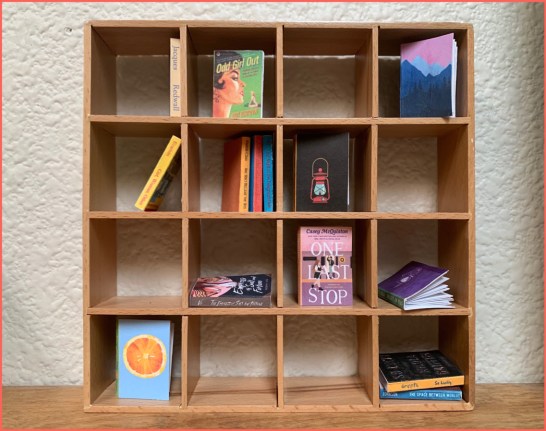
Here is something true about me: I forget things a lot. All the time, really. Maybe it’s an ADHD thing. I forget to text people back; I forget what stories I’ve told. I forget my friends’ birthdays — sorry, friends! I love you! I forget what season of a TV show I’m on and whether I ate lunch today. And maybe more than anything else, I forget which books I’ve read.
When I used to spend way too much money on books, this wasn’t much of a problem; I could just check my shelves. But last year, when I started checking books out from the library, I realized I was putting books on my waiting list over and over again, only to get five chapters in and remember I’d already read them. The problem was compounded when I started checking e-books out from the library and reading them without ever even seeing their covers.
Then, on one of those days when I’d accidentally ended up on the crafty straight mom side of TikTok, I saw a video by a woman who was creating small replicas of the books she’d read that year and tossing them into a decorative jar. I scoffed at her jar — is it even TikTok if you’re not judging, just a little bit? But I knew right away that I wanted to start making tiny books.
I began with office supplies, a few colored pencils, and a dream. Those first books I made were cute, but very crooked. They were cut unevenly with sewing scissors and held together with staples. They didn’t even open. I can’t do these things halfway! So I bought some craft supplies and tried to remember what I’d learned in my one-hour bookbinding seminar in college. Now, every time I finish reading a book, I get to work on its tiny counterpart, and I’ve got a shelf full of minis that make me happy every single time I look at them.
Wanna make one with me?
Today, we’ll be recreating the cover of Odd Girl Out, a pulp fiction classic by Ann Bannon. I haven’t read this one in years, but the cover is so gloriously pulpy, I couldn’t help myself.

First, we’ll make our inner pages. Using your white paper, cut 15 sheets that measure four by three centimeters each. I use a ruler and an exacto knife, but you can use scissors too.

Fold your sheets in half, hamburger style (was that a thing at your elementary school, too?). If you want to get fancy, use a folding bone to set the crease; I’m using the little red tool that came with my iPhone’s screen protector. Then, sort your pages into three sets of five sheets each. Nestle the five sheets into one another.

Once you have your little signatures of five sheets each, you can sew each signature together. I usually use white thread, but I used red here for visibility. My stitches definitely aren’t proper bookbinding technique, but they work! If you want to be fancy, you can create a miniature awl by pushing the eye of a needle into a cork and poke your holes before you sew them together so you don’t wrinkle your pages while sewing.
Once you’ve sewn up your signatures and tied them off, set them aside. You may want to put them under a heavy book — or clip them with a binder clip — so they’ll stay flat later.

Now it’s time to design your cover! I use Canva, but you could easily use Microsoft Word if you’re comfortable working with images and text boxes. I find my cover images on Goodreads. If you’re artistic and don’t have a printer, you can also hand-draw your cover! You’ll want the cover to be slightly larger than your signatures, so the front and back covers should be about 2.4 cm wide by 3.4 cm tall, with a spine that’s about a half centimeter. Print or draw your cover on card stock, if you have it. Cut your cover down to size.

I find that scoring the card stock makes it much easier to fold. Placing the cover right side-up, use a nail or the blunt end of your needle to press four dots into your cover to delineate the edges of your book’s spine. Turn the book over, and run the blunt end of the needle along the ruler to score your two folding lines.
Now that you’ve got your cover, you can put it together with your signatures! Pressing your three signatures together, run some glue down the spine, and then place them directly into your cover. Wipe away excess glue and put your book under something heavy to dry. We did it!

Someday, maybe, I’ll get to the stage where I’m printing a chapter of the actual book inside. For now, these tiny blank pages are there to do what I like with. How will you fill yours?







